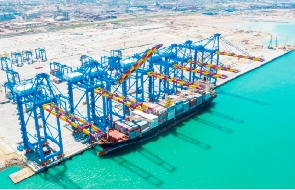 The indication is that imports in first-quarter dropped by 24.52% compared to same period in 2019
The indication is that imports in first-quarter dropped by 24.52% compared to same period in 2019
Ghana’s seaborne trade in import and export volume in the first quarter of 2020 recorded a net effect of negative 43.3% compared to the same period in 2019.
The indication is that imports in first-quarter dropped by 24.52% compared to same period in 2019 – in total of 2.7 million metric tonnes, which comprised 205, 573 metric tonnes of Liner Cargo; 112, 662 metric tonnes of Break Bulk; 1.63 million metric tonnes of Dry Bulk cargo; and 747,727 metric tonnes of Liquid Bulk imports.
In the same period of 2019, however, Liner import recorded 1,273,127 million metric tonnes; Break Bulk 299,399 metric tonnes; 1,088,039 million metric tonnes of Dry Bulk; 907,906 metric tonnes of Liquid Bulk.
According to the Ghana Shippers Authority’s maritime trade review, total export trade volume for 2020 first quarter was 996,331 metric tonnes, representing a 66.1% decrease compared to 2019. This figure was made up of 458,684 metric tonnes of Liner items; 148,429 metric tonnes of Break Bulk items; 338,390 metric tonnes of Dry Bulk items; and 50,830 metric tonnes of Liquid bulk.
Import commodities such as chemicals, processed food/beverages, general cargo, limestone, grains/flour, petroleum products, iron/steel/plates/pipes, bagged rice and other liquid bulk saw major declines for 2020 and 2019 respectively.
These nine (9) import commodities recorded about 64% of the total decrease in import trade volume for January to March 2020. And some major export commodities – including manganese, timber logs, and bagged cocoa beans – also experienced a fall.
Cumulatively, these commodities contributed to about 96% of the total volume decrease recorded in the export trade volume for the period January to March, 2020.
Direction of Ghana’s Seaborne Trade
Ghana’s seaborne imports for 2019 came from the Far East range, representing 41% of Ghana’s total import trade. Africa was next with a 21% share, followed by the North Continent and Mediterranean Europe range at 12% and 11% share respectively of Ghana’s import trade.
The major commodities imported from the Africa range were petroleum products, clinker, frozen meats/foods, and Liquified Petroleum Gas (LPG).
996.331 metric tonnes of seaborne exports for Q1 2020 went to various destination in the world, with a majority of these exports going to the Ear East range and accounting for a total of 428,819 metric tonnes, making 37% of the seaborne exports – whil the North East Continent range received a total of 127,351 metric tonnes, representing 24% of total exports with major commodities such as bauxite, cocoa, beans, cashew nuts, and timber logs.
These ranges of decline experienced by the Ghana shipping industry were a result of the outbreak of coronavirus; also, affected global merchandise trade by volume fell by 3% year-on-year in the first quarter of 2020.
“COVID-19 has affected trade negatively; this downward trend is expected to continue in the latter part of the year 2020,” it stated.